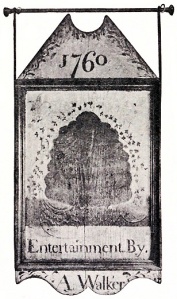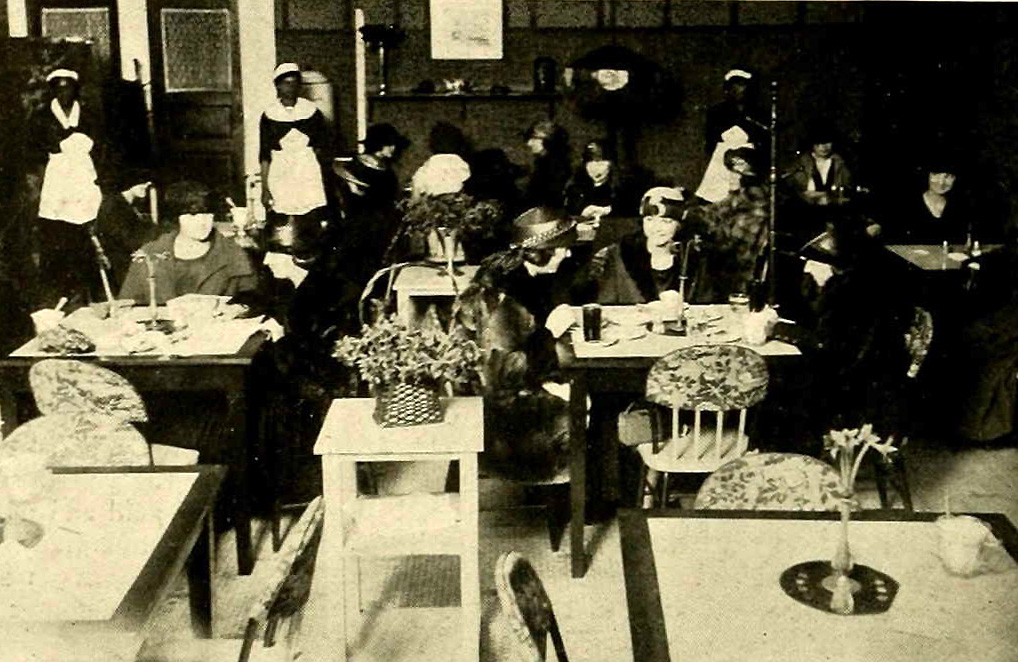In the 19th century Black waiters staffed most Northern restaurants and hotel dining rooms, particularly as hotels grew larger and better appointed beginning in the 1840s. Earlier, Black waiters in the North were mostly employed in private residences or for catered events.
Before the Civil War, the hotels were run on the American plan where meals were included with lodging and served family style. Mealtime was often a mad scramble, putting waiters under great pressure to bring out the dishes. They were often ridiculed, or seen as having no other virtue than being imposing-looking in uniforms.
After the Civil War, when the tipping custom spread, they were suspected of being interested solely in tips. Nevertheless, jobs as waiters were sought after and those who held them were highly respected in Black communities. Headwaiters, occupying a role similar to that of maitre d’, enjoyed the highest status.
A number of Black waiters rose in their profession and took the role of advisor and trainer of their fellow servers. An early example was Tunis Campbell who published The Hotel Keepers, Head Waiters, and Housekeepers’ Guide in 1848. He presented the headwaiter’s role as similar to an officer whose troops need a lot of drilling lest they became undisciplined and boisterous when facing a mob of impatient guests. His advice was put into practice, judging from an English traveler’s description of a remarkably choreographed scene in the 1850s. He reported that, “At a given signal, each [waiter] reaches over his arm and takes hold of a dish . . . at another signal, they all at the same moment lift the cover, all as if flying off at one whoop, and with as great exactness as soldiers expected to ‘shoulder arms.’”
Some patrons preferred Black servers to white ones, and it was said that the better restaurants and dining rooms of the post Civil War period preferred them to whites, particularly the Irish. But praise was often blended with condescension. A prominent Chicago hotelier noted that Black waiters were the “best.” But he added, “They are waiters by nature, and are peculiarly adapted to servitude.” Another admirer of Black waiters commented in a similar way: “White waiters always have an idea that they are doing a man a great favor if they serve him promptly and are polite and respectful. Colored waiters know their place and keep it, give themselves no airs, and take no liberties.”
Never did it seem to occur to white commenters that the best Black waiters had actually chosen to dedicate themselves to their profession and constantly improve their skills. Nor that they were performing a role rather than conforming to their nature.
Unsurprisingly, given the lack of a wide range of job opportunities, many Black men were known for their long tenure as waiters. Still, it is interesting that a Chicago restaurateur noted with surprise in 1899 how many Black waiters “find their way to the variety stage.” Perhaps they had been drilled in the Campbell method. [Blaney Quartette poster, 1898]
The position of headwaiter was especially coveted, particularly if a Black man was tall and impressive looking in a uniform, often a tuxedo in the 20th century. However, although some remained, by then the position of Black headwaiter was being replaced by restaurant owners and hostesses taking over the job of greeting and seating guests.
In the late 19th and early 20th centuries a white backlash against Black Americans generally reduced work opportunities even further, threatening Black predominance as waiters. Immigrant men arriving in this country proved willing to accept jobs as waiters. However, there was a notable reason to favor Black men, one that hindered them at the same time. As a Black waiter explained in 1903, for Black men being a waiter was “usually the zenith of his industrial possibilities” and because of this there was strong competition among them for these positions. This allowed hotels and restaurants to pay them less than white waiters.
By the 20th century, white women also took jobs serving in restaurants, often replacing Black men. Actually, though, the Fred Harvey organization may have pioneered the shift from Black men to white women. In 1883 the men – considered troublesome – were replaced at one of the eating houses on the Santa Fe Railroad line, launching the phenomenon of the “Harvey girls.” Unlike white women, Black women were not often found waiting in white restaurants, but were more likely to be working in the kitchens. When they did occupy waitress roles, white patrons seemed to enjoy seeing them dressed in mammy costumes.
Black waiters organized mutual aid societies and employment bureaus as early as the 1820s, but many were skeptical of labor unions. When strikes failed, their distrust was intensified and they felt they had been betrayed by the white unions, particularly after losing their jobs and being replaced by white men and women. A failed strike at a lunchroom chain in Chicago in 1903 was long remembered with bitterness. Leading Black waiters supported advancement for Black waiters, but not of joining unions. John B. Goins wrote in his book (The American Waiter, 1908) that “unions will never be of any benefit to a colored waiter.” In an even stronger vein, he advised, “Keep out of strikes. If you are asked to join in a strike for better wages refuse point blank. And I would advise you to offer to quit; but first explain why you do so, stating your reason for quitting is to keep out of strikes.” His ally, Forrest Cozart (author of The Waiters’ Manual), was another strong proponent of improvement, urging Black waiters in American plan hotels to learn to read and write because such hotels were disappearing. [Forrest Cozart shown below]
Though there were still an appreciable number of Black waiters through the 1920s, competition with whites increased during the Depression of the 1930s. Then, even native-born whites who had long objected to taking service jobs began to compete successfully, significantly reducing the number of Black waiters.
After World War II, when the economy had improved, dining out for pleasure increased substantially in this country. Black waiters discovered that they were often shut out of waiting jobs in fine restaurants where there was a chance to make good tips. Possibly, though, Black waiters were favored in Southern restaurants such as the elegant Justine’s in Memphis, which hired a strictly Black waitstaff from its beginnings in 1948 until closing in 1995. The restaurant made much of the fact that many of its waiters stayed on the job for many years, yet there were signs of dissatisfaction on their part such as walkouts and complaints about low wages. Many had full-time day jobs.
A 1985 case study found that, unlike immigrants, Black men were not eager to be waiters in low-priced restaurants and that they were not often hired in the better eating places. How much this was due to racist attitudes on the part of managers and/or patrons was not clear. But the study noted that even “when the supply of European waiters fell during the sixties, New York City’s full-service sector did not hire blacks into these relatively high paying jobs, but used artists and actors instead.”
By 1970 Black servers, either male or female, made up only 16% of all waitstaff according to research by Dorothy Sue Cobble (Dishing It Out, 1991).
© Jan Whitaker, 2022



























































 It's great to hear from readers and I take time to answer queries. I can't always find what you are looking for, but I do appreciate getting thank yous no matter what the outcome.
It's great to hear from readers and I take time to answer queries. I can't always find what you are looking for, but I do appreciate getting thank yous no matter what the outcome.


